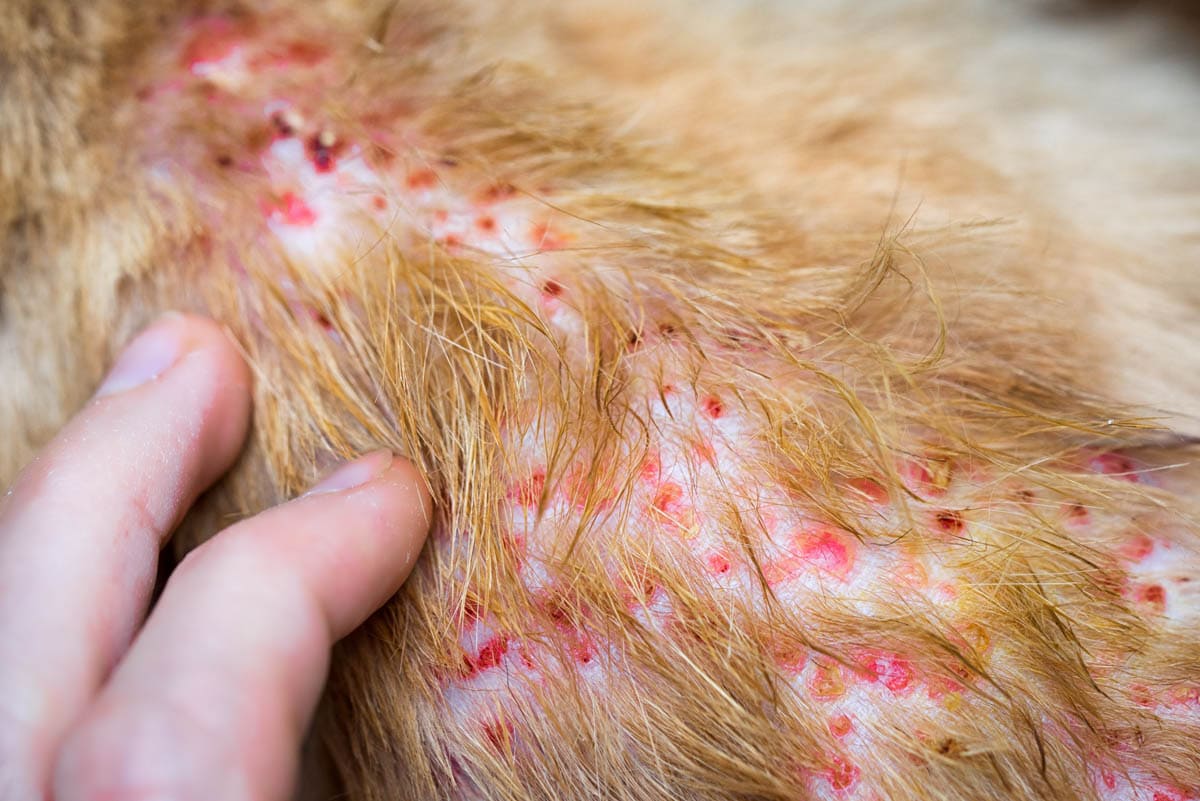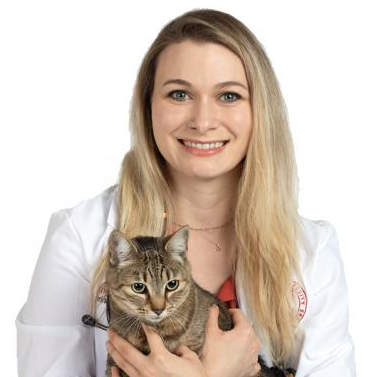About
Scabs are dry, crusty lesions or pustules which can be singular or multiple. There are many causes of scabs which include allergies, parasites and immune system disorders. The type of scabs, location, and accompanying symptoms can all give your veterinarian an indication of the possible cause.
Untreated, scabs can lead to secondary bacterial infections, so it is always essential to have ,any scabs, lumps, bumps or rashes seen by a veterinarian.
Causes
The cause of cat scabs can split into the following categories:
- Allergic
- Parasites
- Skin disorders
- Other
Top medical conditions causing scabs on cats
There are many types of medical conditions that can cause scabs on cats. This includes:
1. Flea bite hypersensitivity
Flea bite hypersensitivity is the most common cause of scabs on cats. Cat fleas are wingless parasites, the adult flea lives on the cat’s skin, feeding off his blood. Many cats develop an allergy to the saliva in flea bites, causing a localised reaction.
Symptoms: Raised crusty bumps (miliary dermatitis) on the skin, common areas include the face, neck, groin, armpit (axilla), back (dorsal lumbosacral) and base of the tail, frequent scratching, licking and biting, self-trauma, hair loss, secondary bacterial infections due to trauma, fleas or flea dirt in the coat and on bedding.
Treatment: Diligent flea control includes flea treatment for the cat as well as the home. Antihistamines can help to control itchiness. I have battled FAD in one of my cats for quite some time. Recently I switched them over to Comfortis (Spinosad), a once a month tablet and his condition cleared up completely.
2. Food allergy
Cats can develop allergies to several things including food. A cat can develop an allergy to a type of food after having eaten it for years.
Symptoms: Food allergies typically affect the head, ears and neck area, causing non-seasonal itching, which may progress to small papules and large areas of open and weeping scabs. Other symptoms may include hair loss, vomiting, and excessive licking of the affected area.
Treatment: If the veterinarian suspects a food allergy, the cat will be put on a novel diet (i.e., a type of food the cat has not had before, such as duck or kangaroo) to see if the symptoms clear up. The cat is then challenged by resuming the usual diet to see if the symptoms return. If they do, food allergy is the cause. Treatment involves switching your cat to a different hypoallergenic diet.
3. Contact dermatitis
Contact dermatitis occurs when your cat comes into contact with an irritant such as soaps, shampoos, plants, medications, etc.
Symptoms: Common symptoms of contact dermatitis include non-seasonal itching, which can cause damage to the skin and the formation of small scabs. Commonly affected areas include areas without much fur such as the ears, underbelly, paws, etc.
Treatment: Identification and elimination of the substance causing contact dermatitis is the best solution.
For mild cases, over-the-counter antihistamines can help to control itching.
Corticosteroids for cats whose contact dermatitis has become unmanageable. These medications reduce inflammation, itching, and swelling, which allow your cat’s skin gets to recover.
Antibiotics may be necessary to treat secondary bacterial infections.
If the condition flares up again, further investigation will be necessary to determine what is causing the allergy. At which time a patch test will be necessary.
4. Inhalant allergy
Inhalant allergy (atopy) is an allergic reaction caused by breathing in airborne particles such as pollens, dust mites, storage mites in dry food, and molds. Humans typically react to inhaled allergies by sneezing and wheezing. However, cats are more likely to develop skin problems. Inhalant allergy is the third most common type of allergy to affect cats.
Symptoms: Non-seasonal itching, which can cause damage to the skin and the formation of small scabs. Commonly affected areas include areas without much fur such as the ears, underbelly and face.
Treatment: Remove the irritant if possible, switch to a canned diet. Antihistamines and steroids can be used to help control the itch.
5. Mange
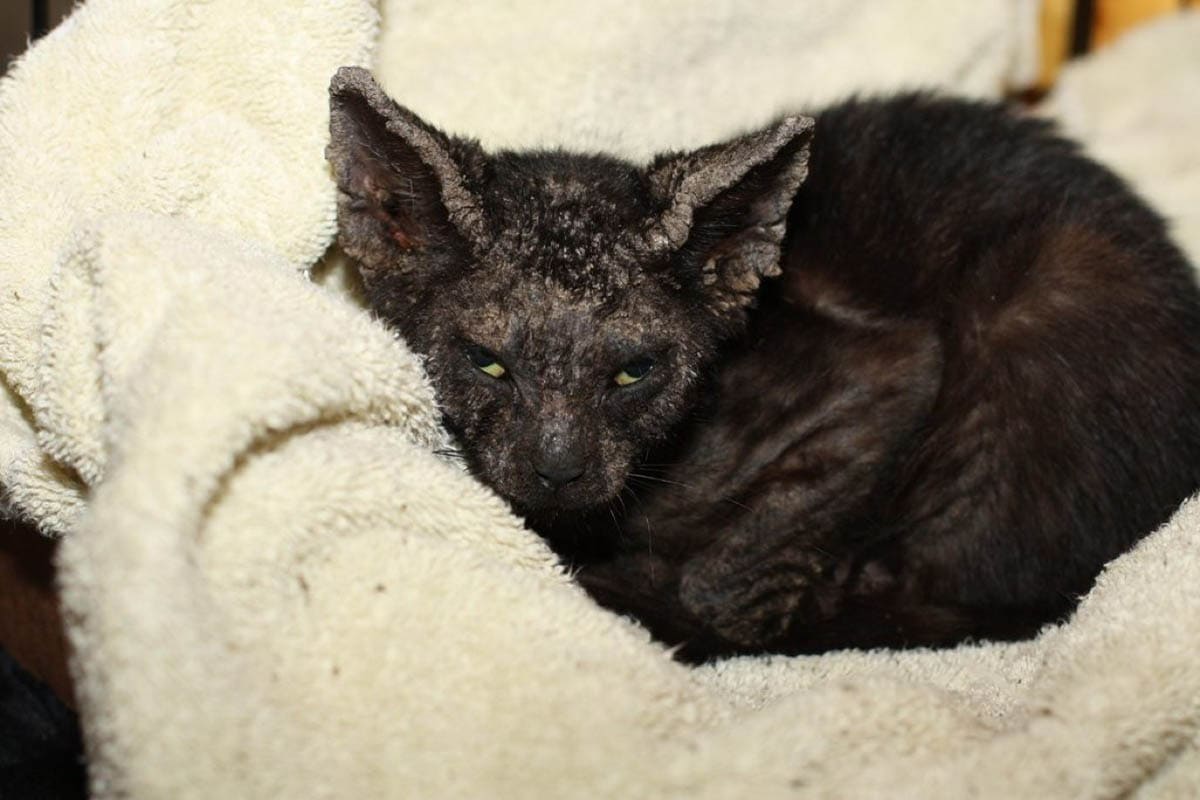
Image courtesy Monica R., Flickr
Mange (feline scabies or notoedric mange) is a highly contagious condition caused by a tiny spider-like parasite that burrows into the cat’s skin.
Symptoms: Intense itching and scabs, especially along the ear margin which may become thickened. The head and neck are the most commonly affected areas, left untreated, the mite can move to other parts of the body.
Treatment: Semi and longhaired cats may need to be clipped. Cleansing of the area to soften thick crusts, followed by a weekly lime sulfur dip at 2.5%.
Ivermectin is given by injection once a week for 4-6 weeks. This treatment hasn’t been approved for use in cats, although reports are that it is safe at sub-toxic levels. Ivermectin can cause blindness and neurological damage at inappropriate doses.
Revolution: This product is typically a flea and worm product but has shown to be effective on notoedric mange.
Treat all cats in the house and wash bedding at the same time as treatment.
6. Demodicosis
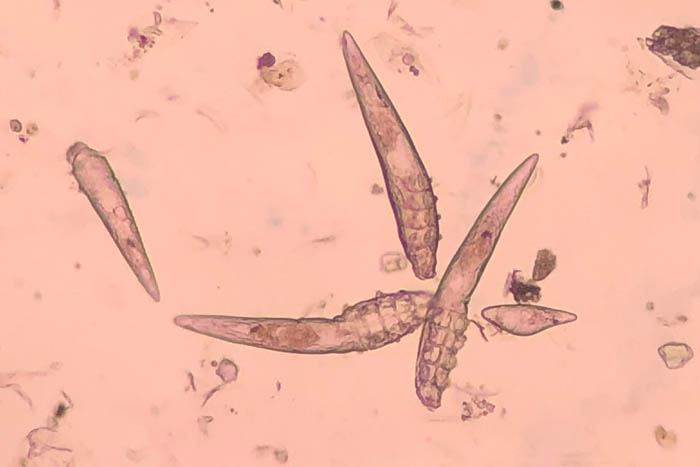
Demodicosis is an inflammatory skin disease in cats caused by the Demodex mite. There are two species, Demodex cati and Demodex gatoi which infect cats.
- Demodex cati is long and slim, living within the hair follicles.
- Demodex gatoi is shorter, living within the surface layers of your cat’s skin.
Demodicosis is a common infection in dogs, but rare in cats and when it does occur, it is usually in cats who are immunocompromised or malnourished. Diseases such as diabetes, hyperadrenocorticism (Cushing’s syndrome), feline leukemia virus, feline immunodeficiency virus and use of immunosuppressive drugs can all predispose your cat to develop demodicosis.
Transmission occurs through direct cat to cat contact. Most cats remain asymptomatic. However, those who have a weak immune system can go on to develop clinical signs of demodicosis.
Symptoms: Itching, overgrooming, single or multiple areas of thinning hair along with crusting fluid-filled sores. The head, neck, and ears are the most common areas.
Treatment: Find and treat the underlying cause where possible as well as medications to kill the mite. Spontaneous remission may occur in untreated cats, especially those with localised demodicosis.
- Lime sulfur dips or shampoos for four to six weeks. Continue treatment until skin scraping tests return negative.
Other treatments may include the following:
- Daily or weekly ivermectin for four weeks. Monitor the cat during treatment and only use it as guided by your veterinarian due to the risk of toxicity.
- Wash bedding and blankets in hot water, and hang in the sun to dry.
- Treat all cats in the household.
7. Ear Mites

Ear mites are a common spider-like external parasite that causes significant discomfort to the cat. Although the name would suggest otherwise, ear mites can live on any part of the body although they generally live in the ear canal of cats. They are the most common cause of otitis externa (inflammation of the outer ear canal) in cats.
Symptoms: Intense itching, waxy buildup, coffee-like grounds in the ears, and eventually damage due to trauma from scratching and secondary bacterial infection may develop. It affects kittens and outdoor cats most often, however, cats of any age can become infected.
Treatment: Removal of the exudates from the ear by instilling a few drops of mineral oil and gently massaging the base of the ear. This will loosen the exudate, which will make it easy to remove.
The veterinarian will be able to prescribe a commercial insecticide to kill the mites. Products vary from country to country. These treatments must be carried out over several weeks; it is not possible to kill the eggs or pupae. Treatment aims to kill adults as they reach maturity and break the life cycle of the mite.
Treat all household cats and dogs at the same time.
8. Ringworm
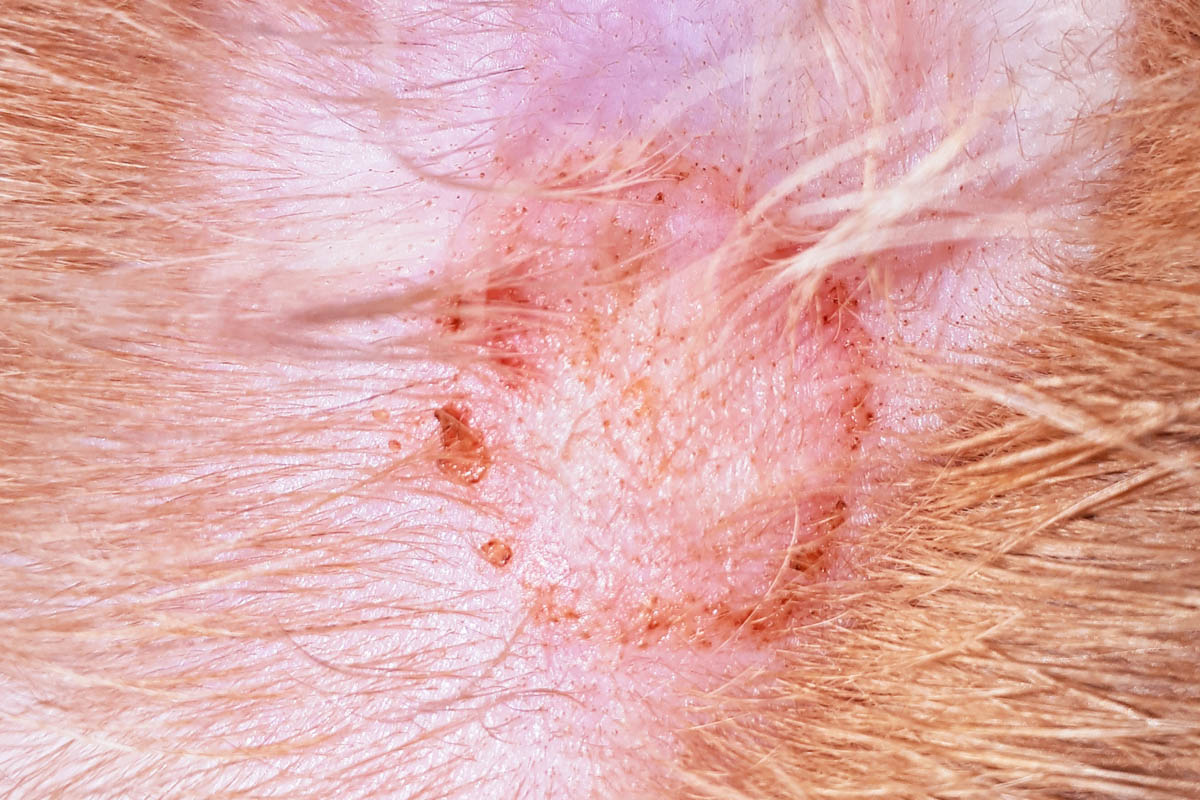
Ringworm is a common fungal infection that affects the skin, fur, and nails of cats. The cause is a microscopic group of parasitic, fungal organisms (dermatophytes).
Ringworm invades the dead, outer layers of the skin, claws, and hair. The name ringworm comes from the ring-like, circular lesions which develop on the cat’s skin. The fungus is more common in areas of high humidity and temperatures.
Kittens and senior cats, cats in crowded environments such as catteries and shelters are at increased risk. Persian and Himalayan cats appear to be more predisposed to the disease than other breeds which may suggest a genetic component.
Symptoms: The appearance of bald patches of circular lesions. Lesions may become itchy, which leads to the formation of scabs. Ringworm lesions are typically larger than most other causes of scabs in this article.
Treatment: Once a diagnosis has been made, it will be necessary to treat both your cat and the home. If you live in a multiple cat household, it will be essential to treat all cats at the same time. It is easier if you can keep all cats confined to just one room while treatment is underway to avoid spreading spores around the home. The veterinarian will prescribe a shampoo or dip to treat ringworm. Treat all cats in the household.
9. Feline acne
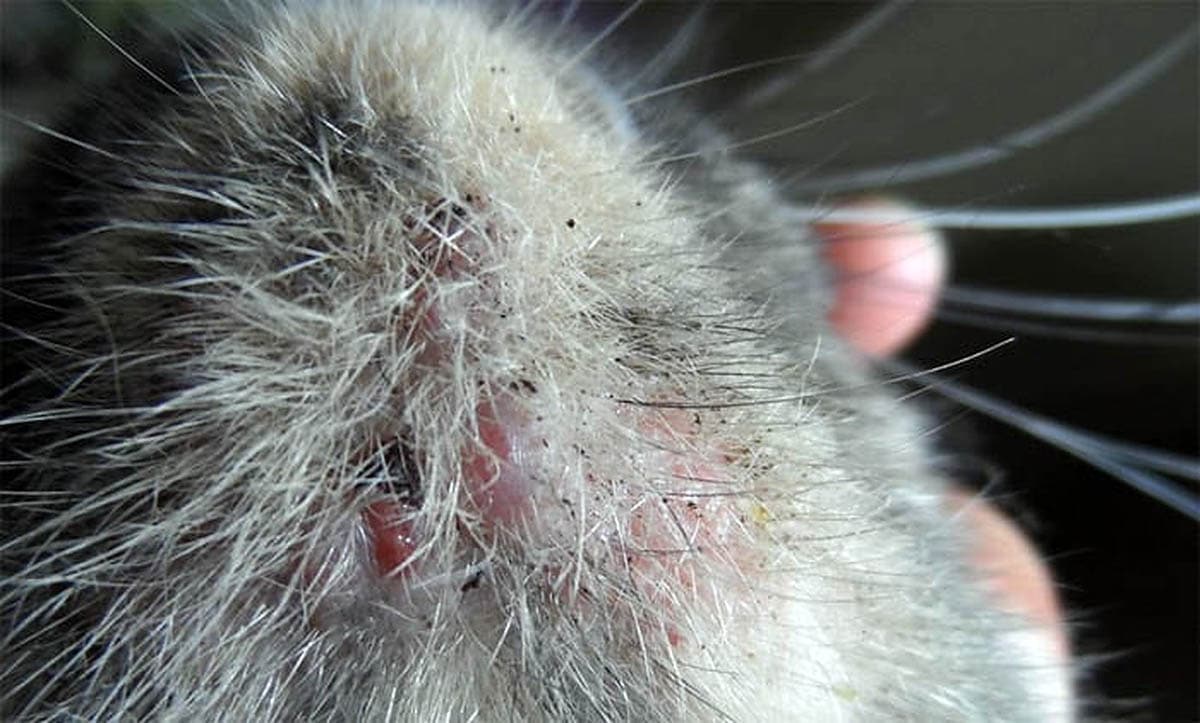
Image © Dianne, Flickr
Feline acne is a condition in which blackheads and inflammation develop on the chin. There are many causes including the use of plastic food bowls, allergies, inflammation and poor grooming.
Symptoms: The appearance of blackheads on the chin, which may be mistaken for dirt. Blackheads can become inflamed and form crusts, scabs, and swelling.
Treatment: For mild acne, clean the chin with antibiotic soap or Betadine or in. More severe cases may require ointments or gels that contain benzoyl peroxide such as OxyDex. Oral antibiotics to treat secondary infections and topical steroids to relieve itchiness.
Switch from plastic to glass or metal bowls and wash after every meal in warm soapy water.
10. Eosinophilic granuloma
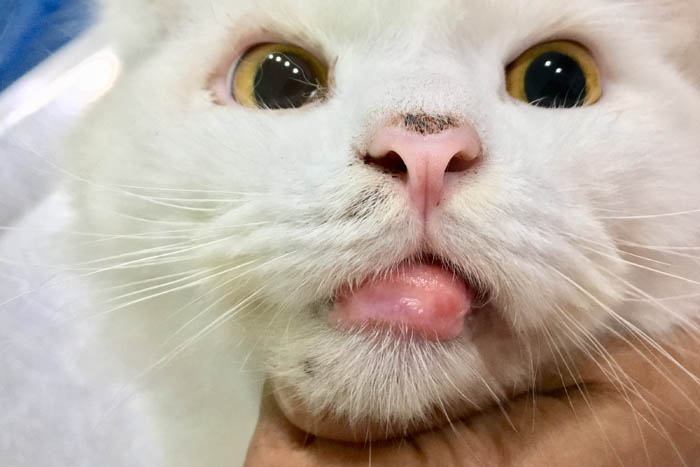
A condition characterised by the presence of skin lesions on various parts of your cat’s body. The exact cause isn’t known, but it is believed it may be the result of specific allergens such as flea bites, food or inhalant allergens. Some cats may only have one outbreak, while in others the condition can come and go.
Symptoms: There are three types of lesions:
- Indolent ulcer (rodent ulcer) most often occur on the upper lip with a raised, thickened area that is well defined and glistening,
- Eosinophilic plaque can develop on any part of the body and appear as a raised, hairless lesion that may be ulcerated
- Eosinophilic granuloma appears as yellow/pinkish lesions usually along the back legs.
Treatment: Avoid exposure to allergens where possible. Zyrtec, an antihistamine has been shown to relieve symptoms. Steroids to reduce inflammation and in severe cases interferon, an immunosuppressive drug. Surgery will be necessary for lesions unresponsive to treatment.
11. Pemphigus complex
Pemphigus complex is a group of rare bullous autoimmune diseases in cats, which are the result of an overactive immune response against the cat’s tissues. An overproduction of autoantibodies attacks the epidermal bonding molecules causing them to separate, resulting in the formation of superficial vesicles and bullae (a blister that contains serous fluid) which rupture to form crusted erosions on the skin. There are three types of pemphigus that affect different layers of the skin.
- Pemphigus foliaceous affects the top layer of the skin.
- P. erythematosus, is the second most common form which affects the head and feet.
- P. vulgaris the rarest form in which lesions grow on the mouth, claw folds, armpits, and groin.
Symptoms: Symptoms vary depending on the type but may include distribution of pustules around the mouth, face, neck, feet, and groin with crusts and hair loss.
Treatment: Immunosuppressive drugs such as oral prednisolone, or in milder cases topical steroids. Chlorambucil, a chemotherapy drug can be prescribed for unresponsive cases. Antiboitics may be prescribed to treat secondary infection.
12. Abscess

An abscess is a pocket of pus under the skin which occurs when bacteria, which reside on the skin or teeth, enter the body via a puncture wound, most often by a bite during a cat fight.
An inflammatory response occurs, drawing vast amounts of white blood cells to the area and increasing regional blood flow. Pus forms, which is an accumulation of fluid, toxins, living and dead white blood cells, dead tissue and bacteria. A thin membrane (pyogenic membrane) surrounds the abscess. This area begins to grow, creating tension under the skin and further inflammation of the surrounding tissues. As the abscess expands, the skin thins and weakens, eventually causing the abscess to rupture, and the pus drains out.
Symptoms: If the abscess hasn’t drained, there will be a hot extremely painful lump under the skin your cat may also have a fever, and go off his food. If it bursts and drains, there will be a foul odour, as well as discharge. Once this has occurred the wound will form a scab.
Treatment: The goal of treatment is to lance, clean, and debride the area to promote healing.
Undrained abscess:
The fur around the abscess is clipped and cleaned, the abscess is lanced and the pus drained, any dead tissue will be removed (debrided), and the area is flushed with sterile saline until the liquid runs clear. This procedure will be under heavy sedation or general anaesthetic. The cat may need to stay in the hospital for a day or two while he recovers.
Drained abscess:
Treatment is much the same as above, minus lancing. The area is clipped and cleaned; the wound is flushed with sterile saline any dead tissue is removed.
If the abscess is large, your veterinarian will insert a surgical drain to assist with the removal of pus — flush daily with antiseptic or sterile saline as advised.
A long-acting antibiotic injection or oral antibiotics will be given.
13. Stress (overgrooming)
Cats display signs of stress in many ways, and there are many causes of stress in cats including changes in the home environment, new pet, family member, moving house.
Symptoms: Stress manifests in many ways, and some cats will hide, or go off their food, other cats will engage in excessive grooming (overgrooming). This can lead to damage to the skin and the formation of crusty scabs on the coat. Common triggers include a change in routine, new family member (animal or human), moving house, sickness.
Treatment: Stress is managed in several ways, including removing the cause of stress if possible, giving your cat a regular and set routine. Play therapy and anti-anxiety medications.
14. Adverse reaction to topical flea products
There are several popular topical (spot-on) products to treat cat fleas. While they are incredibly convenient, some cats can develop a skin reaction.
Symptoms: Loss of hair, redness, rash, ulceration or in severe cases loss of skin.
Treatment: This may vary depending on the severity of the reaction but may include antibiotics to prevent secondary infection and painkillers. If your cat has had an adverse reaction to a topical flea product, there are several alternatives such as tablets and chews.
Do not ever purchase topical flea medications from stores that are not pet-care-oriented. Over the counter products have been implicated in lethal toxicity in cats.
15. Bacterial infections (pyoderma):
Pyoderma is an infection of the skin that can develop due to trauma, such as itching and scratching which damages the area.
Symptoms: Irritation and inflammation of the skin result in crusty pustules. Immunocompromised cats are more at risk for pyoderma as it is an opportunistic infection.
Treatment: Oral antibiotics, as well as topical antibiotics, applied to the affected area to clear up the infection and to address the underlying cause (if known).
16. Insect bite or sting
Insect bites and stings can cause a localised reaction which leads to intense itching.
Symptoms: Scratching can damage the skin resulting in a wound that heals and scabs over. If you notice one or two small scabs on your cat, it is likely due to a bite or sting.
Treatment: Benadryl (antihistamine) can control itching and discomfort in cats who have severe reactions. Dosage is 1 milligram (mg) per pound, or 2 mg per kilo, twice a day.
17. Sunburn
Cats are prone to developing sunburn on areas of their body with thin or no fur such as the ear tips and nose. Light coloured cats or cats with no hair (such as the Sphynx) are, particularly at risk.
Symptoms: Reddened skin and hair loss of the affected area, more severe cases may develop itching and thickening of the skin. Over time, this may become damaged and form sores that dry into scabs.
Treatment: Topical or oral steroids to treat severe sunburn and antibiotics to treat secondary bacterial infections.
Keep cats indoors during the hours of 10 am – 2 pm to avoid sunburn. Anybody who has experienced sunburn knows how painful it is, and just like humans, cats can develop cancer from exposure to the sun (see below).
18. Skin cancer
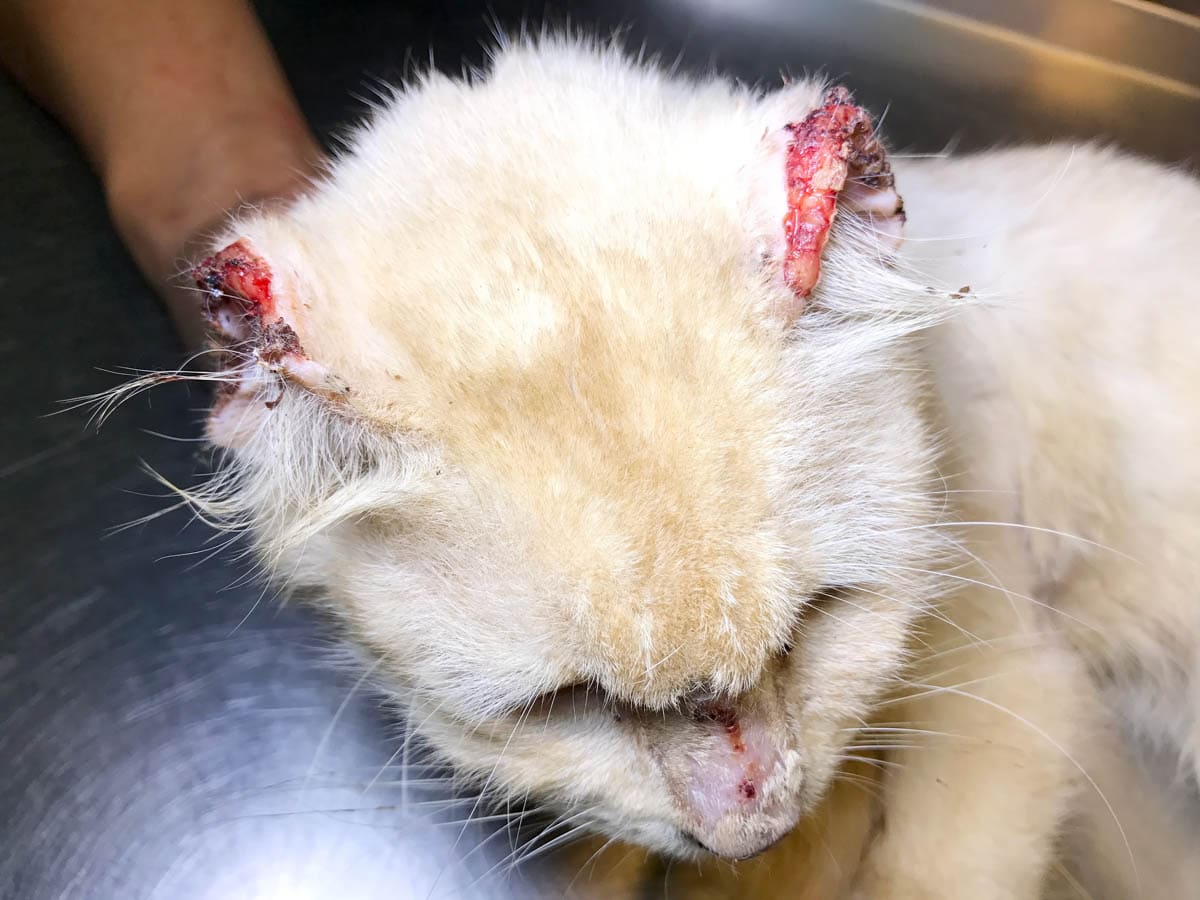
Several cancers can affect the skin which includes melanoma, basal cell carcinoma, squamous cell carcinoma, and mast cell tumour. Areas with little or no skin are most at risk, which includes the ear tips and the nose. Cats with light coats are at higher risk due to the lack of melanin in the skin.
Symptoms: Firm lump underneath the skin which may be hairless or pigmented (melanoma), red and crusted sores or ulcers that don’t heal.
Treatment: Surgery to remove the affected area with a wide margin. Chemotherapy or radiation therapy may be necessary as a follow-up for tumours where removal is not possible.
When to see a veterinarian
Many cats with the diseases described above will be uncomfortable or painful. Infections of the skin are often minor but can become severe and cause significant systemic complications. Immune-mediated diseases or cancers require early diagnosis for intervention and better outcomes. Any cat that has shown signs of skin disease should be assessed by a veterinarian sooner rather than later. While most of these conditions are not life-threatening, they can seriously impact your pet’s quality of life. Urgent care is recommended for abscesses or localized reactions to medications.
Diagnosis
Your veterinarian will perform a physical examination paying close attention to the type and location of the scabs. He will obtain a medical history from you, which may include the following:
- How long have the scabs been present?
- Do they come and go?
- Do they occur at a particular time of the year (spring, summer, etc.)?
- Have you noticed any other symptoms?
- Is your cat taking any medication?
- Any changes to the home environment?
- Does your cat have any other concurrent diseases?
- All of these can help your veterinarian to determine a possible cause.
Diagnostic workup:
There are several diagnostic tools available to determine the cause of scabs on cats; these include:
- Wood’s lamp: A simple way to diagnose ringworm is to use an ultraviolet Wood’s lamp, although only around 30-50% of ringworm isolates will fluoresce. Wood’s lamp examination will likely be positive in most cases of M. Canis dermatophytosis.
- Skin scraping test: To look for skin parasites such as mites or fungi. An area of skin is shaved (if necessary, often the fur is missing). Two drops of mineral oil are then put on the skin, and a blade is used to scrape the superficial layers, which are then examined under a microscope. The test is mildly uncomfortable, similar to a graze, but not unduly painful.
- Skin cytology: To check for inflammation, parasites, fungi, bacteria. This is similar to a skin scraping test although. A sample of the lesion is taken using a cotton bud, for microscopic evaluation.
- Skin biopsy: A sample of skin tissue is removed, prepared and evaluated under a microscope.
- Food trials: This test is to determine if a cat has a food allergy and involves feeding a novel diet containing ingredients your cat has not previously consumed to see if symptoms improve.
- Skin prick test: To check for allergies. A patch of fur is shaved, and several needles containing a few common allergens (such as dust mites) is injected into the skin. If there is a reaction at the site of one or more skin pricks, this will show your veterinarian your cat is allergic.
- Trichogram: The microscopic examination of the hairs may help to identify fungal infections such as ringworm or Demodex mites.
- Fungal culture: The veterinarian gently scrapes the surface of the skin with an unused toothbrush, or plucks out some hairs from the affected area to obtain a sample. The sample is placed onto a culture medium which is stored in a dark and warm location to encourage fungal growth. It can take several weeks to obtain results.
- Fine needle aspiration: A fine needle obtains a small sample of a mass or cyst for microscopic evaluation (cytology).
- Biopsy: A biopsy involves the surgical removal of a small sample of skin (or other tissue) which is evaluated under a microscope. There are two main types of skin biopsy, punch and scalpel. A punch biopsy uses a circular punch tool to remove a small section of skin., while a scalpel is used to remove larger skin samples, such as lumps on or under the skin.
Home remedies for cat scabs and what you can do at home to help
Available remedies for skin disease are quite vast depending on the type of underlying condition.
Omega-3 fatty acids are essential fats meaning cats are unable to synthesize them themselves and need to obtain them via their diet. There are several health benefits including reducing inflammation and improving coat quality. These supplements can be purchased online, at a pet store, or through your family veterinarian.
Soothing shampoos containing oatmeal can help to relieve itchy skin conditions. There are multiple shampoos available for skin conditions. If your cat has a bacterial or fungal infection consider products with antiseptic or antifungal properties.
Antihistamines can help to relieve itching associated with allergies. They are not a cure but can help in the short term.
Cats that are prone to over-grooming caused by stress may benefit from Feliway diffusers or anti-anxiety medications. Calming supplements containing tryptophan are available and have been shown to improve stress. You can also purchase bodysuits or clothing designed for cats to limit excessive grooming.
Feeding a novel protein may help improve atopic dermatitis. Try a limited ingredient diet that contains a single protein like rabbit, venison, or kangaroo. These diets must be fed alone for several months to see improvement in clinical signs.
If your cat has fleas, your entire home and all the pets inside must be treated to prevent reinfection. Using flea and tick prevention year round can prevent issues like flea bite allergies, mosquito bites, mange, and other parasitic infections.
Frequently asked questions
Will my cat’s scabs and itchiness go away?
- Once the underlying condition is treated and any secondary infection has resolved, clinical signs should begin to improve within days to weeks.
Are scabs on cats contagious?
- There are multiple causes of scabs in cats that are contagious such as fleas, mange, Demodex, ear mites, and ringworm.
Is dermatitis in cats painful?
- Cats with open scabs and skin infections are often painful and benefit from analgesic medication.
Can cats get dry skin?
- Absolutely. Dry skin is often caused by underlying skin diseases, lack of appropriate levels of fatty acids, poor nutrition, poor grooming, and chronic systemic diseases like hyperthyroidism and chronic kidney disease.
Can I put Neosporin on my cat?
- NO. Neosporin is not safe to use in cats as it contains polymyxin B which can cause serious anaphylactic reactions.
